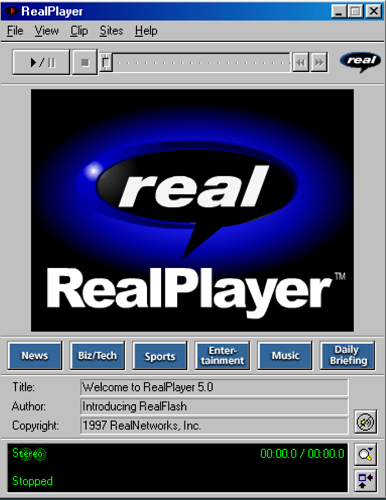Although I did an early review of streaming video, it must be said that I grossly underestimated the potential for the new technology.
Streaming Video 10/16/1997
by H.B. Koplowitz
While typing these words into my computer, I’m watching astronauts aboard the Russian spacecraft Mir give a press conference. [Mir “deorbited” in 2001.] The image on my computer screen is tiny, blurred and jerky, and the sound fades in and out. Still, without being an Internet wiz, I’m able to see and hear a live feed from outer space on my modest home computer. What makes this possible is a new technology called “streaming” audio and video, and NASA TV is but one of the kewl ways pioneers have been using this new medium.
Streaming video has greatly improved over the past year, but it may never be more than a novelty [sic]. By its very nature, it will always look more like a small fuzzy slide show than TV, because streaming video is compressed video, [meaning the video data has been compressed to save bandwidth so it can be sent over wires, which means the quality of the video goes down]. But until they increase the data capacity on the information superhighway, and start making bigger and faster home computers, streaming video is the closest thing to moving pictures and live video that can be transmitted through cyberspace.
A nightclub on the Sunset Strip in Los Angeles called Billboard Live used streaming video to “cybercast” floor shows over the Internet. [Billboard Live closed after a brief run, and Billboard magazine, which owned the nightclub, used the Web address to launch an interactive music site.]

The Billboard Live streaming video required the StreamWorks Player from Xing Technology. In May, StreamWorks presented “Cinemotion – Cannes ’97,” live audio and video from the Cannes Film Festival. Other sites that use StreamWorks to show video online include Capitol Records, HerbaLife live broadcasts from L.A., and the Central Baptist Church from Little Rock, Arkansas, which cybercasts Sunday Services.
The Web site of the American Film Institute offers entire one-reel silent movies and clips from student films. Conventional media like radio, TV and even newspapers and magazines provide streaming news, weather and sports, and studios and record companies use it to sell their movies and CDs. Other industries also use streaming video to promote products. And then there the porno industry, which uses it to deliver pay per view digital sex shows.
For streaming video you should have at least a 28.8 speed modem, and a computer with 16 megabytes of RAM and a 486/66 processor (Apple users should have a PowerPC). You also need an Internet service provider, and a Web browser like Netscape Communicator or Microsoft Internet Explorer. One more thing you need is a streaming video player or plug-in, of which there are several competing brands. Most let you download their players for free from their Web site and have a “gallery” with links to streaming video sites.

To pick up the NASA channel you can use the RealPlayer from RealNetworks <www.real.com>, which became the first Internet broadcaster with RealAudio in 1995. Today, 90 percent of streaming audio is RealAudio, including 400 radio stations. In February, the company introduced a RealPlayer for both audio and video, and now there are more than 1,000 RealVideo sites, including CBS, ABC, MCA, Warner Bros., FOX, ESPN SportsZone, Atlantic Records, MSNBC, MGM, Geffen, Sony and Merrill Lynch.
To view the American Film Institute’s classic silent movies, use the VDOLive Player from VDONet <www.vdo.net>. You can also use VDOLive to see streaming video from NASA, CBS News, PBS and MTV. Last month, VDONet created VDO-Movies <www.vdomovies.com>, which shows streaming video previews of new films from major Hollywood studios, and in July it set up the Web site VDO-Indies <www.vdoindies.com> showcasing independent film producers, and exposing their films to potential investors and distributors. Along with streaming video previews of indie films, the Web site has information about independent movie companies, the films they are planning and those in production.
One problem with streaming video is that your computer tends to run out of memory if you try to view it with your Web browser. But that’s because Web browsers take up a lot of memory, not video players. So here’s a trick:
When you click on a streaming video “channel,” sometimes a screen appears that says you can’t view the channel, but may instead download a tiny file. The file is like a bookmark that lets you view that channel without your Web browser. So download the file, close your Web browser, open your streaming video player, and use that application to open the file you downloaded.
Another trick is to figure out the address of the streaming video channel. A streaming video player can read certain addresses the same way a Web browser can read an “http” address. So to see the NASA channel with RealPlayer, you can tell it to open the location <pnm://zeus.arc.nasa.gov/live.rm>.
To give an idea of just how much memory is saved by not using a Web browser, I was able to have the RealPlayer playing NASA, StreamWorks playing Billboard Live, and VDOLive playing AFI’s silent movie, all at the same time.

